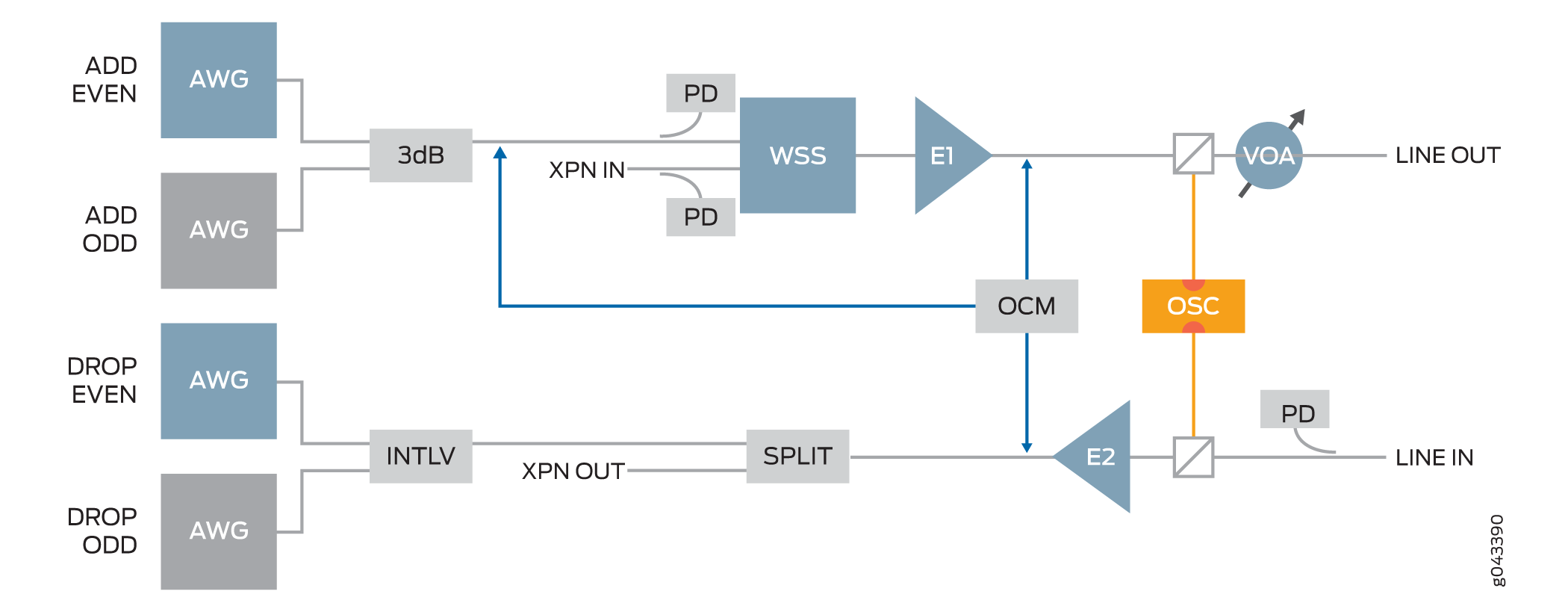IPLC Architecture and Functional Components Overview
This topic provides an operational and configuration overview of the IPLC.
Architecture Overview
The IPLC base module accepts and then multiplexes 32 individual
wavelengths (connected through the ADD and DROP ports on the front panel) into a single fiber pair.
If you require more than 32 channels, you can connect the optional
IPLC expansion module to the IPLC base module to increase the port
capacity of the node to 64 ports.
The wavelengths from the ADD and DROP ports are then amplified, monitored, and controlled
and then transmitted towards the optical network over the Line OUT port on front panelof the IPLC base module. In
the reverse direction, the received signals from the optical network
on the Line IN port are amplified to overcome
for loss in the optical fiber and then demultiplexed into individual
wavelengths and sent to the configured ADD and DROP ports on the front panel.
The 32 channels provided by the IPLC base module are known as the odd channels. The 32 channels provided by the optional IPLC expansion module are known as the even channels. This odd and even designation reflects the default wavelengths the channels support.
In the multiplexing-add path, the 32 even channels from the IPLC expansion module are interleaved with the 32 odd channels from the IPLC base module. In the demultiplexing-drop path, the 32 even channels are separated from the odd channels using a deinterleaver. All 64 channels go through the main common components used for amplification and equalization. All 32 channels on the IPLC base module are 100 GHz spaced, per the ITU-T Grid Specifications (G.694.1). The 32 channels on the IPLC expansion module are offset from the IPLC base module channels by 50 Hz.
Single Node Two Optical Line Terminations
The IPLC architecture can also support two-line terminations
on a single node. To form a single node that supports two-line terminations,
simply connect two IPLC base modules together through the PT IN-PT OUT ports on the front panel
and entering a few simple configuration statements in the Junos OS
CLI. The IPLC base module and the expansion module each require a
single FPC or PIC chassis slot. This minimizes slot requirements and
ensures shelf capacity is not sacrificed in single-node east-west
or north-south configurations. These minimal slot requirements are
especially important if you are configuring a single-node, two-line
termination that requires 64 channels using the IPLC expansion modules.
The IPLC base module supports 32 dense wavelength division multiplexing (DWDM) channels. Using the IPLC expansion module, you can increase the number of supported DWDM channels to 64.
Functional Component Overview
The high-level optical functional block diagram of the combined functions of both the IPLC base module and the IPLC expansion module are shown in Figure 1.

IPLC Base Module Functional Components
The main building blocks of the IPLC base module architecture are as follows:
A 2x1 WSS on the add path to select wavelengths from among all channels presented from the 32 add ports of the IPLC base module (shown in blue in Figure 1) and from the 32 add ports on the IPLC expansion module (shown in gray in Figure 1).
A booster erbium-doped fiber amplifier (EDFA) (E1) followed by a variable optical attenuator (VOA) to compensate for the loss of the WSS, multiplexer, and 3 dB coupler.
A variable gain preamplifier EDFA (E2) to compensate for the loss of the preceding fiber span.
An optical channel monitor (OCM) with three points of observation including the following:
Booster EDFA (E1) output
Preamplifier EDFA (E2) output
The combined channels of the local add function at the input of the WSS, which indicates which channels (both odd and even channels) are being added locally
An optical supervisory channel (OSC), which communicates inband with the far end IPLC modules and is used for the analysis of the fiber span characteristics, performance monitoring, and IPLC fault handing. Simple topology discovery logic communicates with the ILAs and PTX3000 nodes.
An optical splitter is used to broadcast the received signal from the output of the preamplifier (E2) toward both
DROPandPT INandPT OUTportsFour power monitors:
AWG Add—Monitors the input of the WSS measuring the total input power of the combined channels of the local add function
Express In—Monitors the input of the WSS measuring the total input power at the input to the WSS coming from the
PT INandPT OUTexpress portsLine IN—Monitors the input at the
Line INport, for detection of the incoming line signal optical powerLine OUT—Monitors the output at the
Line OUTport, for detection of the outgoing line signal optical power
IPLC Expansion Module Functional Components
The IPLC expansion module is a passive multiplexer/demultiplexer
that interfaces only with the IPLC base module. The IPLC expansion
module receives its sole input from and delivers its sole output to
the IPLC base module through the PT IN and PT OUT ports. As such, it does not interface directly
with the network or the high-speed backplane of the PTX3000 router. Figure 1 shows the main building
blocks for both the IPLC base module and expansion module.
The main building blocks of the IPLC expansion module architecture are as follows:
Add filter capable of multiplexing 32 DWDM channels of certain wavelengths
Drop filter capable of demultiplexing 32 DWDM channels having the same certain wavelengths
Demultiplexing filter whose input (which is also the sole input to the expansion module) is monitored through a power detector. The power detector determines whether light is present. If light is present, the power detector determines whether the light has reached the expansion module through the patch cord between the IPLC base module and the IPLC expansion module.
